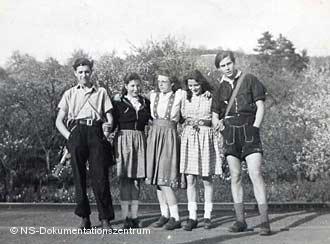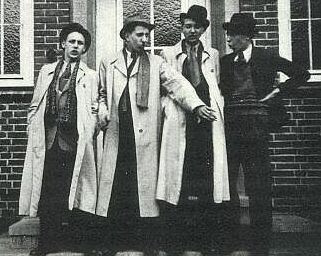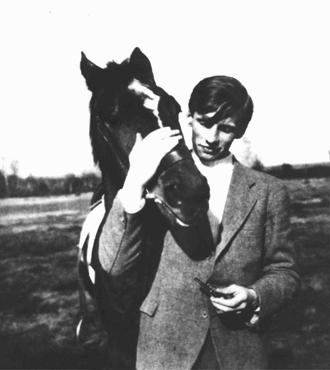
Meet the resisters – Edelweiss Pirates
First they came for the Jews. And I did not speak out - because I was not a Jew. Then they came for the Communists. And I did not speak out - because I was not a Communist. Then they came for the trade unionists. And I did not speak out - because I was not a trade unionist. Then they came for me. And there was no one left to speak out for me. Martin Niemoller
One might think it was impossible in that time and place to oppose Hitler and the Nazis: their program was too powerful, no matter how strong your belief or how deep your faith. The concept of gleichschaltung (forced coordination) permeated every aspect of German life: each action of each citizen synchronized with the aims of Nazi Germany. Nazi Germany was the Borg, the people just drones.
Hutterites

Eberhardt and Emmy Arnold, leaders of the Rhön Bruderhof.
Mennonites may have believed resistance was futile but, had they remained true to their faith, they would not have been alone in opposing the Reich. Not all Christians conformed to the Nazi ideal, including their former Anabaptist cousins – the Hutterites, followers of Menno Simons’ contemporary Jacob Hut. Germany kicked out the Rhön-Bruderhof Hutterites for refusing military service or Nazi teachings. Jacob Hut’s antecedents had lived their quiet communal lifestyle and the Nazis thought they might be communists. When Hitler became chancellor on January 30, 1933, German Mennonites reacted “just like their fellow Germans: they were relieved and cheered Hitler and his Brownshirts with great hope.”[1] Within six months the Hutterites sent all draft-age men and children to a community in Liechtenstein for safe-keeping. On April 14, 1937, secret police surrounded the Rhön Bruderhof, confiscated their property, and gave the remaining community members forty-eight hours to get out. By 1938, all the Bruderhof members had reassembled in England.[2] In England they faced continued persecution, eventually fleeing to Paraguay where they settled.[3] A Swiss newspaper ran the story under a headline which read “German Mennonites Expelled.” Mennonite leaders quickly published their own article under the headline “An Important Correction” and clarified that Hutterites were not associated with the Mennonite church.[4]
Jehovah’s Witnesses

This is how Jehovah’s Witness Barbara Wohlfahrt found out her husband Gregor had been executed. “The death sentence rendered on November 8, 1939 by the Reich military court against your husband Gregor Wohlfahrt was carried out this morning.”
Jehovah’s Witnesses paid a much higher cost to remain true to their faith. They “suffered religious persecution in Nazi Germany between 1933 – 1945 after refusing to perform military service, join Nazi organizations or give allegiance to the Hitler regime. An estimated half of all German Jehovah’s Witnesses went to prison, and 2,000 went to Nazi concentration camps. Twelve hundred died in custody, including 250 who were executed. They were the first Christian denomination banned by the Nazi government and the most extensively and intensively persecuted.”[5] Beheading was the method the Nazis chose most often to punish the unrepentent Witnesses. In Russia they are still persecuted as an extremist organization and have been banned in Taganrog since 2009.[6]
German Christians
Most of Germany’s Christians were Protestant, like the Mennonites. Hitler’s goal was to weld church and state so closely that church would be subjugated to the state and indistinguishable from the state. He signed a treaty with the Pope who agreed the Roman Catholics would not take part in political activity of any kind and in return Catholics would worship in peace. To coerce the Protestant Lutheran, United and Reformed denominations, Hitler salted local church leadership elections with fanatic Nazis[7] who enabled a movement known as the Deutsche Christen (German Christians). At the national Protestant annual convention, Nazi Ludwig Müller was maneuvered into position as the Reichsbischof of the newly minted and synchronized Deutsche Evangelische Kirche (DEK = German Evangelical Church). By its own definition no non-Aryan person could be a member of the German Evangelical Church.
Opposition to the DEK was provided by the Confessing Church, a collection of 3,000 Protestant pastors who believed the State could not make ecclesiastical policy and a Jew who converted was as Christian as anyone else and a full member of the church. In May 1934 the Confessing Church declared “that any State — even the totalitarian one — necessarily encountered a limit when confronted with God’s commandments.”[8] Its leader Martin Niemoller[9] in a 1936 memorandum to Hitler “protested the regime’s anti-Christian tendencies, denounced the regime’s antisemitism, and demanded that the regime terminate its interference with the internal affairs of the Protestant church.”[10] Hitler’s response was to murder the office manager and legal advisor of the Confessing Church, arrest several hundred pastors, confiscate the church’s bank accounts, and forbid it from taking up collections.
Catholic clerics were also harassed and incarcerated. Many were tried on trumped up charges and often housed in Dachau’s Clergy Barracks.
One Easter, the guards marked Good Friday by torturing 60 priests. Tying their hands behind their backs, chaining their wrists, and hoisting them up by the chains – tearing joints apart and killing and disabling several of the priests. The threat of further torture was used to keep the priests obedient. Food was so lacking, that prisoners would retrieve scraps from the compost pile.[11]
Youth Gangs

Edelweiss Pirates in their objectionable uniforms.

Picture taken in 1944 shows members of the youth gang “Edelweisspiraten” at the Beethoven park in Cologne, western Germany. Sixty years after the downfall of Nazi Germany, four members of the group (not in the picture) aged between 16 and 17 years sentenced to death in 1944 will be officially rehabilitated in June 2005. The “Edelweisspiraten” revolted among others against the Nazi youth organization “Hitlerjugend”. AFP PHOTO BLOCKschrift / Privatarchiv Juelich/TONI MASCHNER


What was wrong with the way they dressed?

These hikes were illegal.

Gestapo photo identifying Edelweiss Pirates. It has something to do with the way they wore their socks. No kidding.
German youth rejected Nazi control of their lives in their own ways. Edelweiss Pirates were gangs of children aged 14-17, able to leave school but too young for military service, who refused to join the Hitler Youth, gathered on street corners and mixed with members of the opposite sex. They flouted the mobility rules and went on forbidden hikes, stuffed American propaganda leaflets into mail slots, ambushed and beat up Hitler Youth patrols and during the war helped German deserters. They were also known as the Navajos of Cologne, Kittelbach Pirates of Oberhausen and Düsseldorf, the Ehrenfelder Gruppe and the Roving Dudes of Essen.[12]

These were Russian slave workers accused of having ties to the Edelweiss Pirates. Two weeks later at this same place six teenage Pirates were hanged.
While their behavior may have been of little consequence, their punishment was not. Gang members were rounded up and their heads shaved. Some were sent to concentration camps. In November 1944 thirteen members of the Ehrenfelder Gruppe were hanged in Cologne, six of them still teenagers. Today memorial plaques in the city commemorate their lives.
Swing Kids

Another group of German young people rejected the Nazi ethic through dance and music – the Swingjugend (Swing Kids). They idealized America and Britain and loved swing and jazz music. They danced in a crazy style, swinging their arms wildly and pointing index fingers in the manner of American musicians. “Everything for us was a world of great longing, Western life, democracy – everything was connected – and connected through jazz,” said former Swing Kid Friedrich Ritzel in a 1985 interview.[13] They were 14 – 21 year-old boys and girls who dressed and acted in distinctly non-Aryan ways; boys with long hair, long jackets and Homburg hats, ubiquitous umbrellas, smoking pipes; girls with short skirts, heavy makeup, and with flowing hair, mocking the natural look and braids of Nazi ideals.
The fashion of the Swing Kids made them easily visible to everyone, and by itself was an indication of considerable courage. These rebels openly celebrated their differences from mainstream Germanic society.[14]
 They danced and listened to music in clubs and halls and private homes until August 18, 1941 when 300 of them were arrested in a police operation: the leaders were sent to concentration camps, the rest had their hair cut and forced to return to school under close scrutiny.
They danced and listened to music in clubs and halls and private homes until August 18, 1941 when 300 of them were arrested in a police operation: the leaders were sent to concentration camps, the rest had their hair cut and forced to return to school under close scrutiny.



This is how swing boys dressed.
In the special Jugendschutzlager (Youth concentration camp) the boys were kept in the same block and in songs like “Jeepers Creepers” and “Caravan” expressed their rejection of the Nazi ethos. Gunter Dischler remembers:
The salt mine where we worked had really nice acoustics. One of us played on the cartridges – these were like wooden boxes, and he would play drums with some sticks. We improvised all sorts of things. Sometimes it sounded horrible. Either way, we had successfully gotten through our so-called breakfast break. It was a survival strategy.”[15]
 Swing girls were kept with other female prisoners in Ravensbruck concentration camp under the care of the SS. Survivors recall covering the windows with bedsheets and singing “In the Mood,” or “A Tisket A Tasket” for the other prisoners.[16]
Swing girls were kept with other female prisoners in Ravensbruck concentration camp under the care of the SS. Survivors recall covering the windows with bedsheets and singing “In the Mood,” or “A Tisket A Tasket” for the other prisoners.[16]
In January 1942 Heinrich Himmler, Reichsführer of the SS, gave his prescription for dealing with the Swingjugend to Gestapo boss Reinhard Heydrich:
My judgment is that the whole evil must be radically exterminated now. … it is only through the utmost brutality that we will be able to avert the dangerous spread of anglophile tendencies, in these times where Germany fights for its survival.”[17]
White Rose

Hans and Sophie Scholl
Another of the young resisters was the White Rose, a small group of University of Munich students. Several members had served as medics on the Eastern Front and witnessed the atrocities towards Jews, Poles and others. The group’s tactics were simple – graffiti and leaflets. They self-published six leaflets which they distributed to nine cities and placed in telephone books in phone booths, couriered to other universities and mailed to university professors.

Atrium of the University of Munich where Sophie Scholl dropped the leaflets.
On February 18, 1943, 25-year-old Hans Scholl and his 21-year-old sister Sophie dropped stacks of leaflets outside classroom doors to be found by University of Munich students. Sophie noticed she had a few remaining leaflets and casually tossed them in the atrium from the third floor, watching them flutter down like leaves. Jakob Schmied, the maintenance man, also watched and arrested Hans who still possessed a draft of a seventh leaflet written by colleague Christopher Probst and within four days all three were executed by guillotine. The Nazi People’s Court executed four more members of the White Rose in the following months.
Such a fine, sunny day, and I have to go,” Scholl lamented to her cell mate Else Gebel before she was guillotined by the Nazis. “What does my death matter if by our acts thousands are warned and alerted? Among the student body there will certainly be a revolt.”[18]

Alexander Schmorell on high school graduation.
Many schools, streets, and other places across Germany are named in memory of the members of the White Rose. The Scholls and Kurt Huber have fountains dedicated to their memory, Alexander Schmorell was canonized by the Orthodox church and Asteroid 7571 was named the White Rose.
There are plenty of examples of German men, women and children who opposed the Hitler government. There are many more examples of German citizens who protected Jews at great cost, Oskar Schindler, Jews who helped Jews, Raoul Wallenberg, the Bielski partisan group, attempts to kill Hitler by the armed forces, even the mainstream churches of Germany suffered because they opposed Hitler. Yet the Mennonite church did not suffer. It was too small to matter, and that was fine with the Mennonite leadership. The full extent of their opposition to the Nazi regime was working out an agreement whereby Mennonites were permitted to solemnly affirm, rather than swear, their allegiance to the Führer. Once again the moral compass whirled out of control.
NOTES
[1] Dieter Goetz Lichdi, Ueber Zuerich und Witmarsum nach Addis Abba: Die Mennoniten in Geschichte und Gegenwart (Maxdorf: Agape Verlage, 1983), p. 162 quoted in Mennonite Life, June 1991, The German Mennonite Response to the Dissolution of the Rhoen-Bruderhof, by James Irvin Lichti page 10.
[2] https://www.wikiwand.com/en/Bruderhof_Communities#/ Beginnings_in_Germany_.281920.E2.80.9337.29 accessed March 13, 2017.
[3] https://www.wikiwand.com/en/Bruderhof_Communities. Accessed May 8, 2017
[4] Schroeder, Stephen Mark, Prussian Mennonites in the Third Reich and Beyond: The Uneasy Synthesis of National and Religious Myths, Master’s Thesis, University of British Columbia, April 2001, page 22.
[5] Garbe, Detlef (2008), Between Resistance and Martyrdom: Jehovah’s Witnesses in the Third Reich. Madison, Wisconsin: University of Wisconsin Press. pp. 100, 102, 514 quoted in https://www.wikiwand.com/en/Persecution_of_Jehovah’s_Witnesses_in_Nazi_Germany accessed March 3, 2017.
[6] http://www.independent.co.uk/news/world/europe/jehovah-s-witnesses-targeted-under-russias-anti-extremism-laws-simply-for-practising-their-pacifist-a6756506.html , accessed March 3, 2017.
[7] Barnes, Kenneth C. (1991). Nazism, Liberalism, & Christianity: Protestant social thought in Germany & Great Britain, 1925–1937. University Press of Kentucky, pg 74 quoted in https://www.wikiwand.com/en/Confessing_Church#/Historical_background, accessed May 8, 2017.
[8] Barnett, Victoria (1992), For the Soul of the People: Protestant Protest Against Hitler, Oxford University Press US, page 7 quoted in https://www.wikiwand.com/en/Confessing_Church accessed May 8, 2017.
[9] Niemoller is credited with the following quotation: First they came for the Socialists, and I did not speak out—/ Because I was not a Socialist. / Then they came for the Trade Unionists, and I did not speak out—/ Because I was not a Trade Unionist. / Then they came for the Jews, and I did not speak out—/Because I was not a Jew. / Then they came for me—/and there was no one left to speak for me.
[10] https://www.wikiwand.com/en/Confessing_Church accessed May 8, 2017.
[11] Rychlak, Ronald J. (October 8, 2007). “The Priests of Dachau“. CatholiCity. Archived from the original on 10 July 2013. Retrieved 9 August 2013. Quoted in https://www.wikiwand.com/en /Priest_Barracks_of_Dachau_Concentration_Camp#/Clergy_at_Dachau, accessed May 8, 2017.
[12] Lee, Stephen J (1998). Hitler and Nazi Germany, Routledge. p. 58 quoted in https://www.wikiwand.com/en/Edelweiss_Pirates, accessed May 8, 2017.
[13] Willett, Ralph “Hot Swing and the Dissolute Life: Youth, Style and Popular Music in Europe 1939-49” pages 157-163 from Popular Music, Volume 8, No. 2, May 1989 page 160, quoted in https://www.wikiwand.com/en/Swingjugend accessed May 8, 2017.
[14] German Swing Youth: (English Version by an American Friend of the Swingstyle Syndicate. Copyright by Swingstyle) quoted in http://www.return2style.de/amiswhei.htm accessed May 8, 2017.
[15] Fackler, Guido, Music and the Holocaust, Swing Kids Behind Barbed Wire, http://holocaustmusic.ort.org/politics-and-propaganda /third-reich/swing-kids-behind-barbed-wire/, accessed April 15, 2018.
[16] Ibid.
[17] Cited in Meyer, David N., The Bee Gees: The Biography, Da Capo Press, Boston, MA, 2013.
[18] Else Gebel, letter to Robert Scholl (November, 1946)
Resistance is utile.
LikeLiked by 1 person
Eddie: as always I read your story with great interest and friendly love. I note the reference to the Ellington tune: “Caravan.” I remember playing that song on the clarinet with you on … piano? No, gypsy accordion? Whatever. Alex on drum. Sorry bout that.
LikeLiked by 1 person